When Monet Spells ’10 traveled to Houston last October to attend the Grace Hopper Celebration of Women in Computing, the world’s largest gathering of women technologists, she made sure to bring her Wellesley tote. “I thought, this is the best way to meet people. And it was. I would walk through the hotel lobby, and I would hear, ‘Hey, Wellesley!’” says Spells, who is pursuing a master’s in human-computer interaction at Georgia Tech. Later, she participated in a group photo (below) of Wellesley alums, students, and faculty who had found each other—22 people, all proudly flashing the Wellesley “W” sign. Spells tweeted the photo with the comment, “I found my tribe. My bold, brilliant, boundless tribe.”
It’s a tribe that’s been growing by leaps and bounds at Wellesley. There are 40 declared computer science majors in the class of 2016, making it the fourth most popular major, behind only economics, psychology, and political science. This year, enrollments in computer science courses number approximately 800. Brian Tjaden, associate professor of computer science and chair of the department, says that in recent years, at least 60 percent of Wellesley students have taken at least one computer science course, and next year, he expects that to climb to 70 percent. “It’s a very exciting time,” says Tjaden.
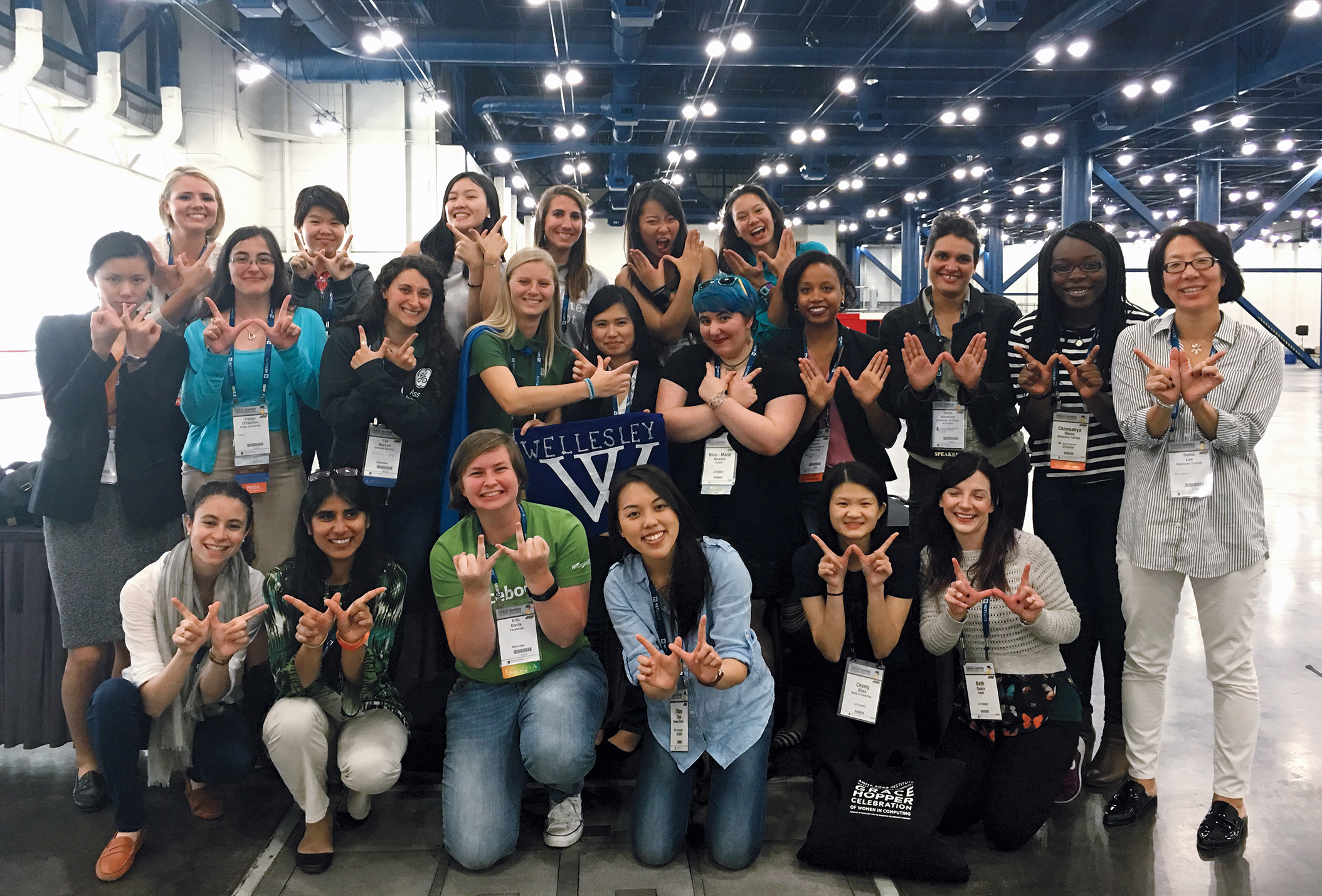
Wellesley faculty, students, and alums posed for a photo at the Grace Hopper Celebration of Women in Computing in Houston last October.
Photo Courtesy of Maria Tilden ’14

Orit Shaer (second from left), associate professor of computer science, offers guidance to her students in CS 320 Tangible User Interfaces.
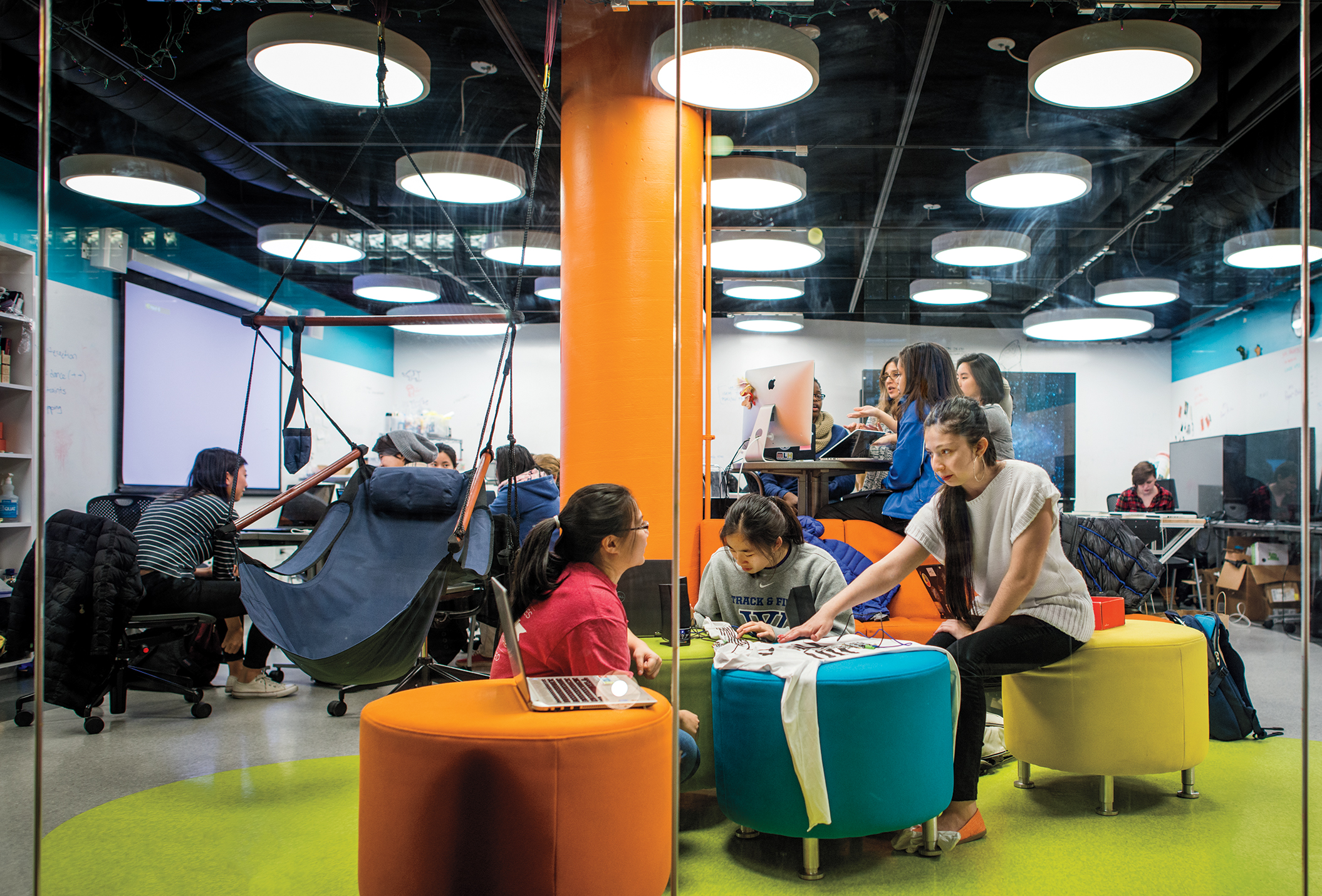
Science, technology, and art come together in the Human Computer Interaction Laboratory, which opened in fall 2013.
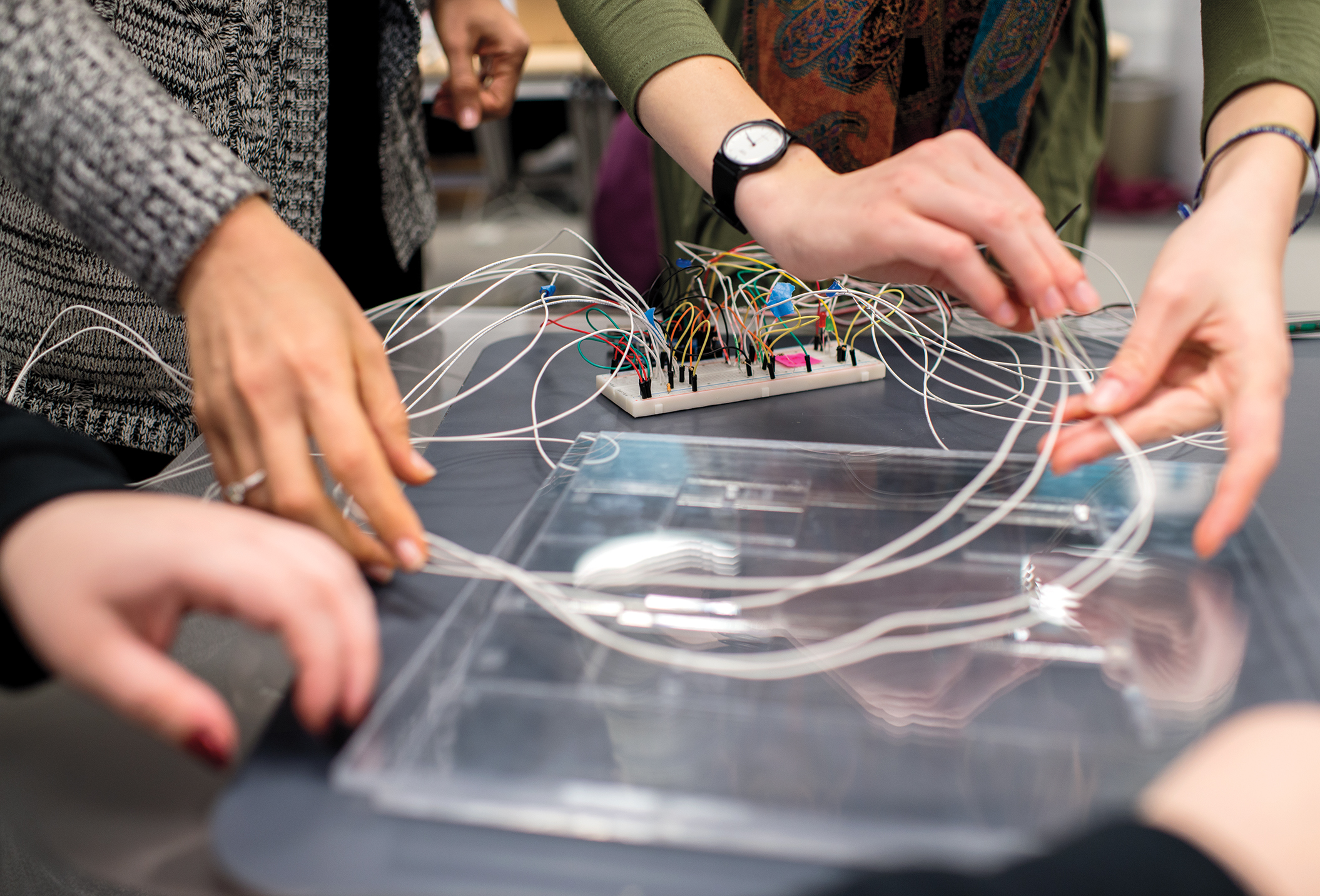
Photo of students wiring an interactive dance floor in CS 320 Tangible User Interfaces.
“It’s true that there is a surge in computer science nationally these days, and computer science has always been a cyclical kind of discipline, where it goes up and down with the foils and fortunes of technology. But the surge today is, nationally, not inclusive of women,” says Cathy Summa ’83, director of the Science Center. In fact, the proportion of women in the field has actually shrunk over the past 20 years, according to the National Science Foundation’s biennial report Women, Minorities, and Persons with Disabilities in Science and Engineering. In 1993, women earned 28.3 percent of bachelor’s degrees in computer science; in 2012, women accounted for only 18.2 percent.
“Wellesley is turning the tide on that by itself. [The department is] bursting at the seams with women who are coming to computer science. I think it’s because [the students] are seeing the relevance of the technologies to whatever else they’re interested in,” says Summa.
Whether students are drawn in by the famously friendly and supportive faculty, the gorgeous new Human Computer Interaction Laboratory, the lure of recruitment from big-name tech companies, or the promise of making a difference in the world through technology, computer science is very hot at Wellesley. And after Wellesley, alums are entering the tech world in droves, helping to turn the stereotype of the antisocial white male hacker on its head.
The Computer Science Department 1.0
The computer science department at Wellesley had its inception in the mid-1960s, when Virginia Onderdonk ’29—dean of the College, philosophy professor, and former World War II codebreaker—asked Ann Congleton ’58 of the philosophy department to join conversations about how to move computer science into the curriculum at Wellesley. (Congleton had experience with computers from working on translation programs at the Research Laboratory of Electronics at MIT.) As a result, in 1968, Extra-Departmental 110 Introduction to Automatic Computation was launched, and 94 students enrolled. The students wrote programs using punch cards. A van would take the cards to MIT, where they would run overnight, and then it would return with the printouts in the morning.
Over the next decade, one or two computer science courses were offered each year. In 1980, Wellesley hired Eric Roberts as a full-time computer science faculty member, and enrollments jumped. In 1982, Academic Council, the faculty governance body, voted to create the computer science department. The first year the department existed, 643 students were enrolled. Randy Shull, who had joined the mathematics faculty in 1980, asked to move to the computer science department at the time it was founded. “I said, ‘I’d like to be a part of this. It’s really too exciting not to be,’” Shull recalls. The early years were exhilarating but exhausting for the faculty. Wellesley was one of the first liberal-arts colleges to found a computer science department, and there were very few guidelines to follow. In 1991, a new wing of the Science Center was built, in large part for the computer science department.
In the years that followed, enrollments waxed and waned, usually following the tech industry. But Shull says that in all his years teaching at Wellesley, the talent and the excitement that’s he’s seeing in students in the department today is unparalleled. “It’s just wonderful. You should see the energy in this place,” says Shull.
Making Computer Science Visible
The energy and excitement in the computer science department is literally on display in the Human Computer Interaction (HCI) Laboratory, a beautiful, modern classroom that opened in the Science Center in 2013. It has an entire glass wall open to the hallway, giving passersby a peek at the unconventional technologies being used inside. “You just walk by there and you think, ‘How do I get in there? What can I take that would be in that room?’” says Erin Altenhof-Long ’16, a computer science and English double major.
The answer is to take a course or do research with Orit Shaer, associate professor of computer science and co-director of the Media Arts and Sciences Program, who studies novel ways for people to interact with technology. Forget the keyboard and mouse—students in Shaer’s lab use technologies like virtual-reality headsets and a table-sized multitouch computer. For example, last fall in CS 320 Tangible User Interfaces, students worked in teams to create new user interfaces that enhance creativity. One group made an interactive dance floor that helped dancers rehearse choreography. Another team created a full-body suit that allows users to play their body like an instrument. “They use beautiful metaphors, like your ribs are a xylophone, or the veins in your arm are like a guitar, and allow people to make music without learning an instrument,” says Shaer.
Many computer science courses emphasize the team aspect of solving problems. “It reflects the practice in the industry, but it also reflects our strong belief that people learn better when they collaborate,” says Shaer.
The HCI lab has also done a lot to facilitate collaboration. “The lab really became a hub for students’ activities. … We have a constant stream of visitors. We were afraid that [the glass wall] would make students feel a little bit fish-tank uncomfortable, but it got them more excited, because they feel that they are noticed, and have opportunities to share their experiences,” says Shaer.
The lab also helped the College get a competitive grant for research equipment from the National Science Foundation, which allowed the department to buy a state-of-the-art, high-resolution interactive screen called a MultiTaction display (like a gigantic iPad, for the uninitiated.) “One reason we were able to get this competitive award for buying this very expensive equipment is that we already made an investment in the space. We said, ‘Look, Wellesley created this state-of-the-art facility. Now we really want to take it to the next level, and house the most innovative technology in it, and make it accessible to the students.’ … The NSF shared our excitement, and here it is,” says Shaer.
While faculty research and the electives being offered change from year to year, the core curriculum has largely stayed the same since the department was founded. The faculty’s goal isn’t to teach students how to use current computer applications, but to make sure they understand how these applications work so they can design and build the technologies of the future. Sohie Lee, a senior instructor who has taught in the department since 2000, comments, “I think that’s part of the liberal-arts education, and what makes our students stronger candidates [for technology jobs] than, say, someone coming from a technical school. They’re good communicators and writers, and people-persons, too, and can interact with people well. … They’re problem solvers, and team players, and strategizers. Those [skills] will always be relevant, I think.”
Call Yourself a Programmer
Erin Altenhof-Long ’16 is one of a growing number of students who came to Wellesley knowing that she wanted to take computer science, rather than stumbling upon it. In high school in Washington state, Altenhof-Long took an Advanced Placement programming course in the Java programming language—she was one of four girls in a class of about 20 students. Because of this, she skipped the introductory CS 111 course at Wellesley. (“Which I honestly regret, because it’s such a bonding thing to all jump into it together … the inside jokes and the camaraderie carries through,” she says.) Instead, she dove into coding with CS 230 Data Structures.
“You can call yourself a programmer after you’ve taken something like 230,” says Altenhof-Long. “It’s such a great course because you really do feel that, wow, I could actually program something that’s useful. … The first time I had a technical interview [for an internship at Google], there was a problem on a data structure called a stack, which was exactly like a problem set I’d done in this course, and then taught as a teaching assistant. It was a good feeling.”
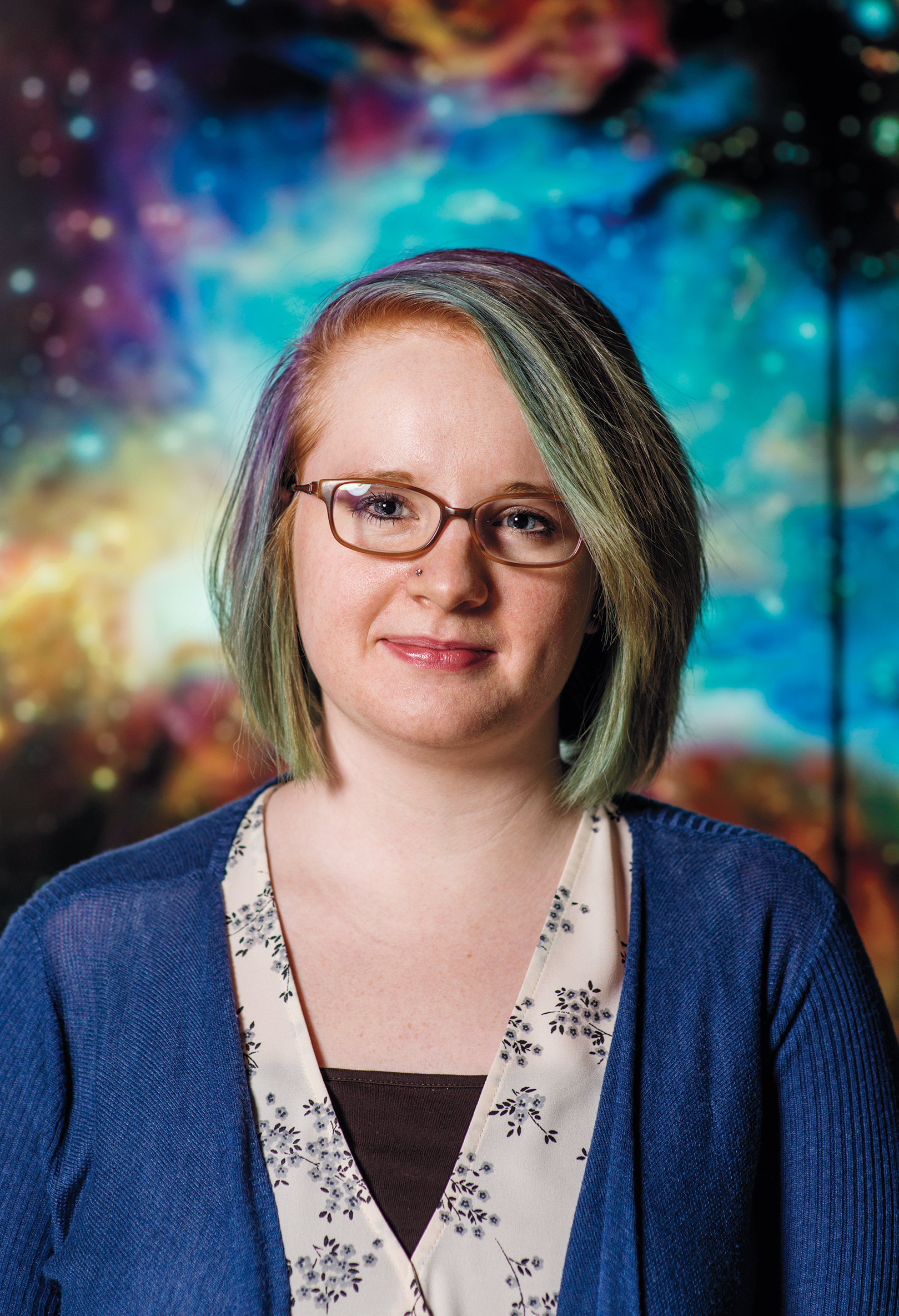
‘I was really glad to have the Wellesley background of being in an environment where it’s just so unquestioned that women can do these things and be successful. … It’s very reassuring to have the normalization of having classes of 40 students who can all handle this material, who could all be great software engineers.’
—Erin Altenhof-Long ’16
Altenhof-Long’s experience as a CS teaching assistant exemplifies the warm, encouraging attitude the department fosters among its students. “[Being a TA is] a job, but it’s also just a really fun thing to do. You get to know people who are your peers who are going to take other classes with you, and it’s also a good way of showing, ‘Hey, I was in your shoes, and I could do this—we can all do this,’” she says.
Like many students, Altenhof-Long has found that her CS skills have crept into her other areas of interest. Unexpectedly, she wound up using the programming skills she learned in Data Structures for an assignment in ENG 271 Topics in Eighteenth-Century Fiction. One of the assignments at the end of the class was to parody the novels they had read. Altenhof-Long decided to “translate” key passages by one author into the style of another author by building a program that would calculate and substitute the most commonly used words in different novels.
For example, the line from Jane Austen’s Northanger Abbey, “No one who had ever seen Catherine Morland in her infancy would have supposed her born to be an heroine,” when run through Altenhof-Long’s program to be translated in the style of Ann Radcliffe’s The Mysteries of Udolpho, became “No one who had sadly seen Blanche Morland in her prospect would have sublime her born to be an cloud.” Nonsensical but delightful Mad Libs for 18th-century literature geeks. “It was one of those [CS projects] where I thought, I guess I could do something short with this …” and then before she knew it, “I was down this weird rabbit hole,” she says, laughing.
Karina Chan ’16 fell down the computer science rabbit hole the spring of her first year, when she took the first-year seminar Creative Computing, team-taught by Sohie Lee and Franklyn Turbak, in which students made simple computer programs using the Python language. “[Lyn’s] energy was very contagious. He made everything so exciting. …” says Chan. “There were about 14 people in the class, and it was very different from other classes I had taken. Very hands-on. [At first,] it’s difficult to grasp the concept, but once you understand the concept, actually doing it is not that hard, if that makes sense. You get a little ‘programmer high’ after you finish a particularly difficult problem.”
Outside of the classroom, Chan is one of the co-presidents of Wellesley’s Computer Science Club, which was founded a year and a half ago and has about 60 active members. One of the club’s main activities is organizing hackathons—marathon coding sessions that bring together programmers and designers to create applications in a short amount of time. An event last October, WHACK (“We Hack Together”), drew almost 100 people—half Wellesley students, and half off-campus guests.

‘The professors are incredibly supportive. In my computing in Python class with [Associate Professor Franklyn Turbak], his energy was very contagious. He made everything so exciting. I think that’s what made me want to go to the next class, and to start the major, and then from there, I just got sucked into it.’
—Karina Chan ’16
“We put [people] on teams with students from other schools, so you can get exposure to what other people know and can bring to the table, and grow from that experience,” Chan says. The hackathon was backed by Major League Hacking, which provided hardware for the event. The winning team made a virtual-reality version of the popular iPhone game TinyWings. “You wear the [virtual reality] headset and you flap, and it’s as if you’re going up and down the hills. It’s pretty sick,” Chan says.
The club also helps students write their résumés and prep for technical interviews. “The things you learn in the department are very theoretical, very foundational, and very important. But to get an actual internship, they expect you to be able to code quickly and efficiently. So it requires some supplemental learning, outside of the class. The CS club is trying to fill that gap,” Chan says. The club also started a big/little siblings program this year, nicknamed “bits and bytes,” to help students get to know each other in the rapidly growing department. “It’s something we’re working on, because we want to keep that tight-knit community,” she says.
Coding Confidence
Monica Feldman ’14, a lead software engineer at Apple, says that her time at Wellesley empowered her. “I took a class at MIT, and I noticed that many of the women weren’t raising their hands,” she says. “I think they may have felt intimidated in that environment—being in the minority in a male-dominated classroom. And you know, computer science is not something most people learn in high school … you have to feel like you can ask a question. You have to feel like you have a relationship with your professors and your classmates. Wellesley totally did that for me.”
Feldman also points to the Wellesley network as an amazing source of support. Over Wintersession her junior year, an alumna helped her secure an internship at Kayak, a travel search engine. “She really helped open the door for me. So whenever a Wellesley student emails, I’m really excited to try to help them and try to open a door for them,” she says.
Mollee Jain ’16, a computer science major who is going to work at Microsoft in Redmond, Wash., after graduation, says, “I really appreciate that there are a lot of women faculty, and they’re diverse, as well. That is something that is nice, because a lot of places have male faculty in vast numbers. Representation at the faculty level translates into representation later on in jobs. … You never feel like you don’t belong in a CS class,” she says.
Brian Tjaden says the department cares a great deal about attracting and retaining underrepresented minorities. “Students who major in CS reflect the diversity in the community better than is the case in other STEM fields, but still not at the level of the Wellesley College community as a whole. So we have important work ahead of us,” he says. One positive step he points to is that the department has the largest set of tutors (teaching assistants) on campus, and the tutor population does indeed reflect the diversity of the Wellesley community as a whole. “Also, last year, we redesigned our gateway course, CS 111 Computer Programming and Problem Solving, to attract and retain students with a diverse set of backgrounds and interests. At this point, it is too early to say to what extent this change will impact the profile of our majors, but we are optimistic,” Tjaden says.
Eni Mustafaraj, an assistant professor who came to Wellesley in 2008, excitedly points out another notable fact about CS 111. This semester, all four faculty members teaching it are women. “I’m not saying that we shouldn’t have male faculty, right? It’s not about that,” she says. “But I think that, especially at the introductory level, the message is, ‘Hey, look, you can do this. Everyone can do this.’”
Wellesley’s First Programmers
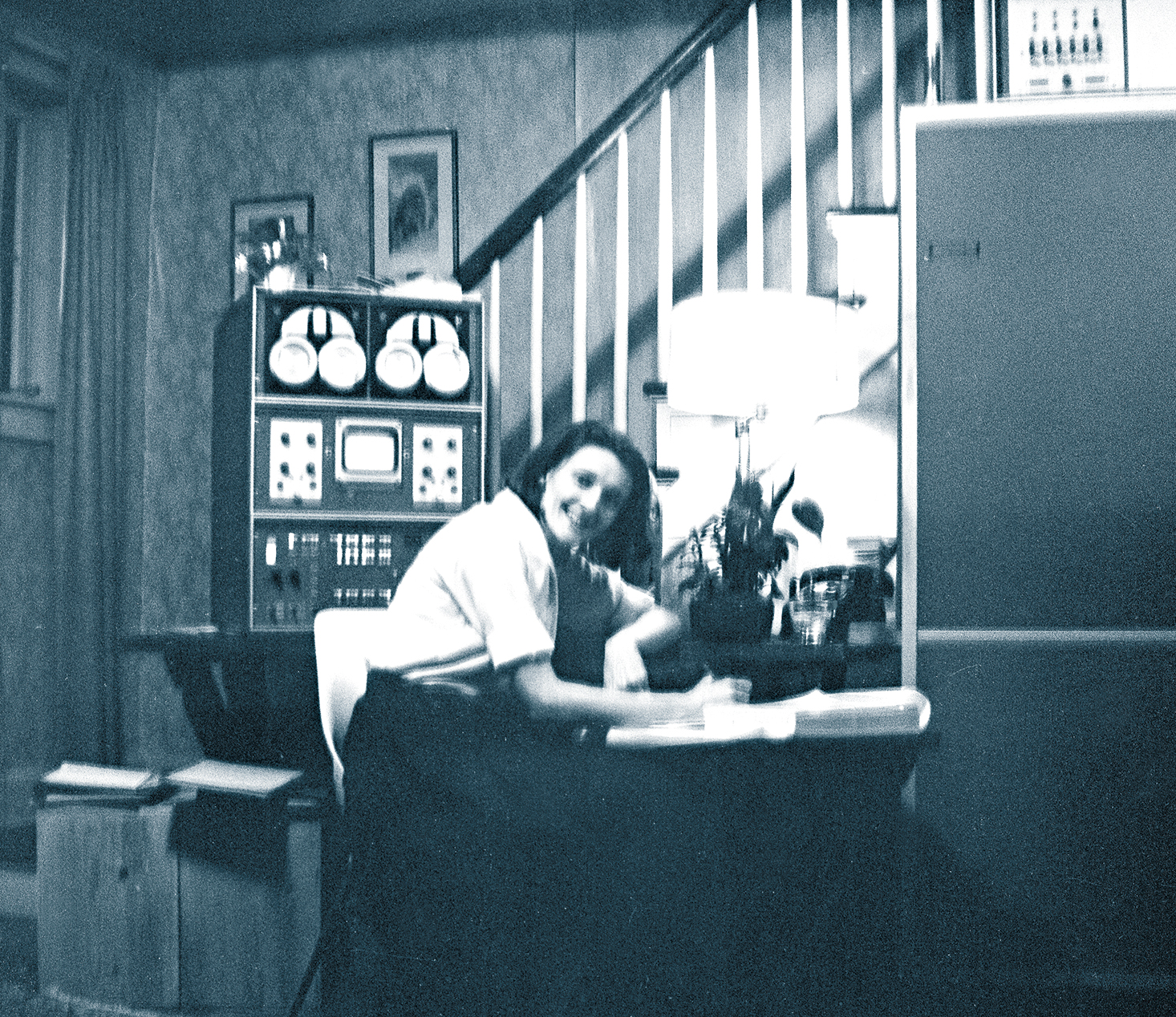
Photo Courtesy of Mary Allen Wilkes ’59
There were Wellesley women in computer science before the major was a twinkle in the mathematics department’s eye. Mary Allen Wilkes ’59 was a philosophy and theology major who dreamed of becoming a trial lawyer. But she was discouraged from applying to law school. The message was, “If you get in, you’re not going to be very happy because of the strong bias against women. … If you get a job, it will probably be as a legal secretary, not as a practicing lawyer. Possibly, if you get a job as a practicing lawyer, you might be able to work in trusts and estates, because all your clients are dead,” Wilkes says.
However, at the time, computer programming, which was seen as clerical work, was relatively open to women. “It’s just like planning a dinner,” pioneering programmer Grace Hopper was quoted as saying in an article titled “The Computer Girls” in Cosmopolitan magazine in 1967. “You have to plan ahead and schedule everything so it’s ready when you need it. … Women are ‘naturals’ at computer programming.”
Wilkes got a job as a programmer at MIT’s Lincoln Laboratory, where she worked with early IBM machines. “Big behemoths. Huge, sealed-off, punched-card affairs,” says Wilkes. There were two categories of technical employees at Lincoln—the professional staff, who were members of the general research staff and who were virtually all men, and the nonprofessional staff of technicians. Programmers, who were almost entirely women, were classified as technicians, although their educational backgrounds were usually comparable to members of the general research staff. “There was a tacit divide between programming, which is really software design, and logic design, which the men did, although the two require exactly the same aptitudes. There was really no reason that the guys couldn’t do programming and the women couldn’t do logic design,” says Wilkes. But the technicians “were paid less. We had fewer benefits. We had less vacation, et cetera,” she says.
However, her bosses “went to bat for me with MIT” and, after two years, got her a general research staff position. At that point, Wilkes was working on the development of the LINC computer, often considered the first personal computer. In 1965, after the LINC team had moved to Washington University in St. Louis, Wilkes worked on a LINC from her parents’ home in Baltimore, where she wrote the LINC operating system. In the process, she became one of the first users of a personal computer in a home. (See photo above.)
“It was like working logic puzzles—big, complicated logic puzzles,” she says. “I also enjoyed the precision of it. I still have a very picky, precise mind, to a fault. I notice pictures that are crooked on the wall. Unless they’re mine, I don’t touch them, but … I think there’s a certain kind of mind that works that way,” Wilkes says.
In 1972, Wilkes left the field of computer science to go to Harvard Law School and pursue her early dream of being a lawyer. She didn’t leave high tech entirely behind, though: After serving as a trial lawyer for many years, she became an arbitrator for the American Arbitration Association, sitting on cases involving information technology.
—L.S.M.
An English major with an affinity for nerd culture, senior associate editor Lisa Scanlon Mogolov ’99 nearly jumped out of her chair with excitement when Erin Altenhof-Long ’16 described her “parodic translator” for 18th-century novels.




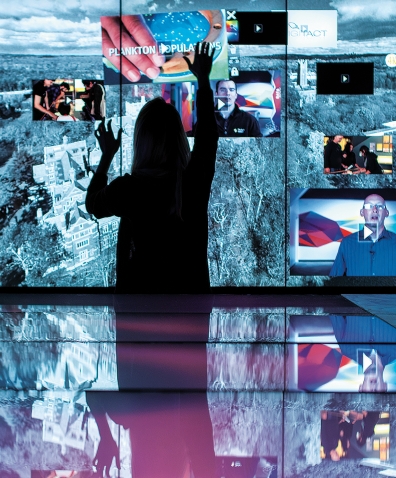









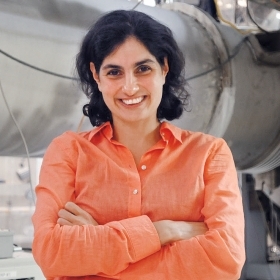
We ask that those who engage in Wellesley magazine's online community act with honesty, integrity, and respect. (Remember the honor code, alums?) We reserve the right to remove comments by impersonators or comments that are not civil and relevant to the subject at hand. By posting here, you are permitting Wellesley magazine to edit and republish your comment in all media. Please remember that all posts are public.